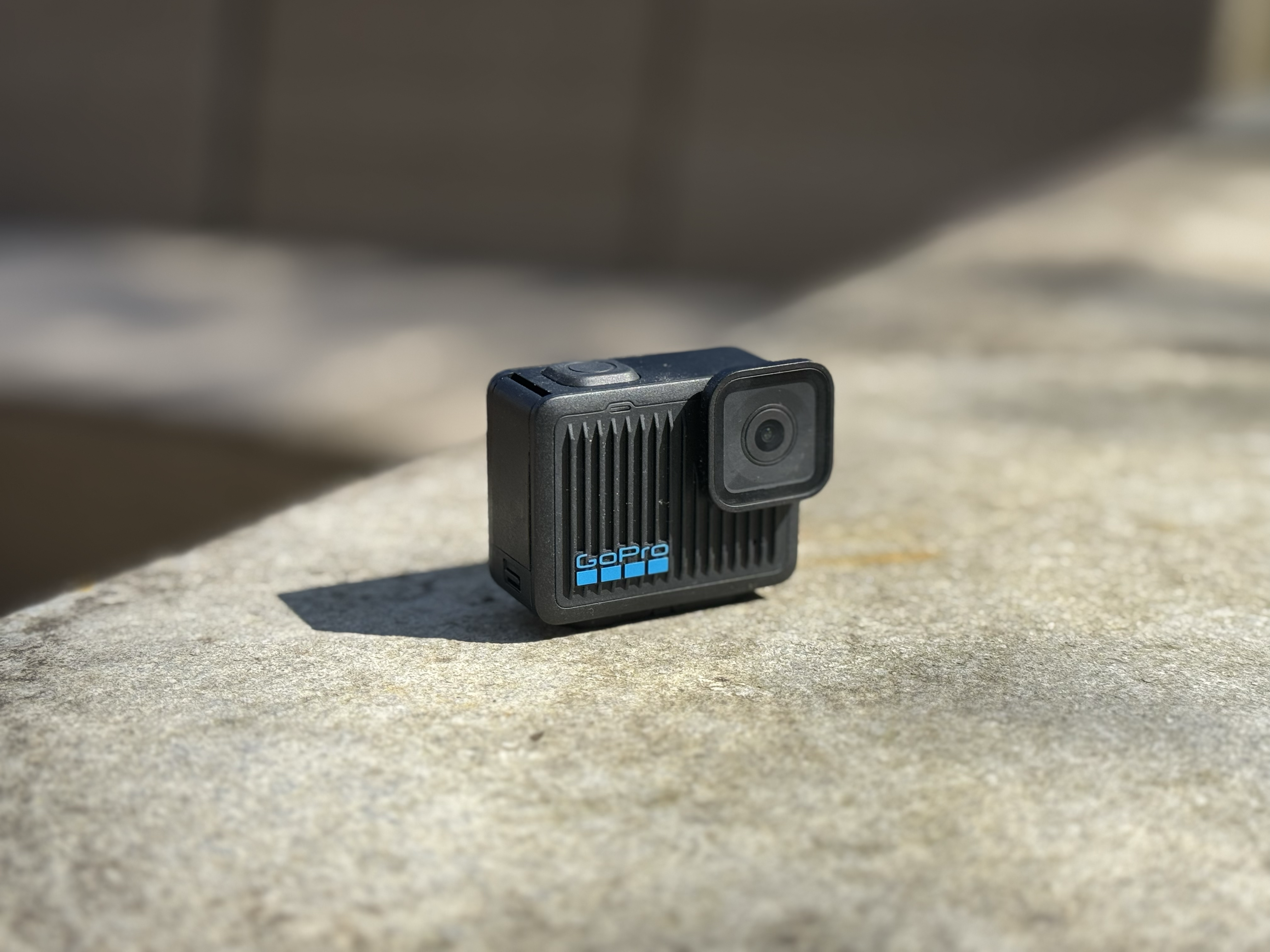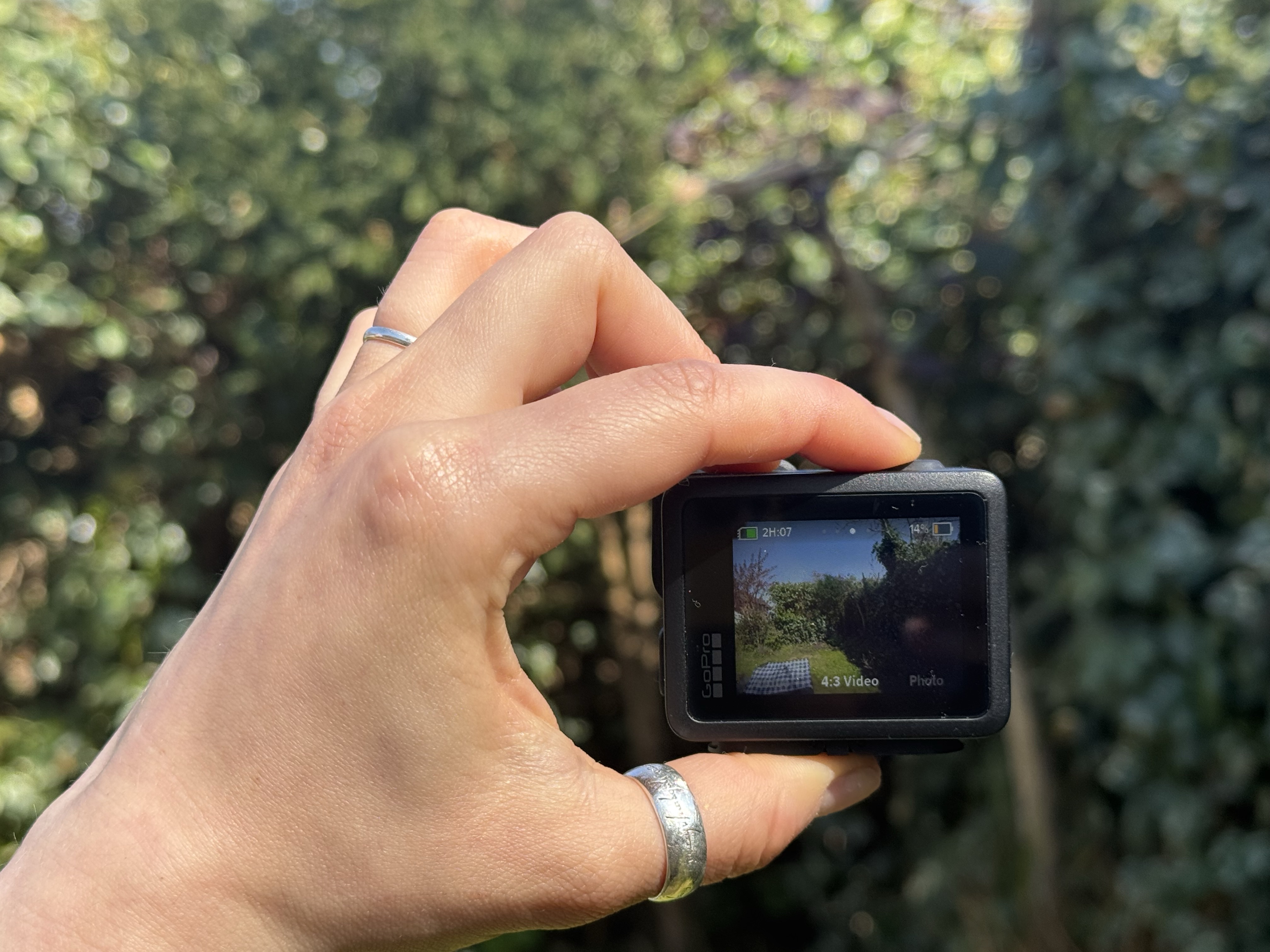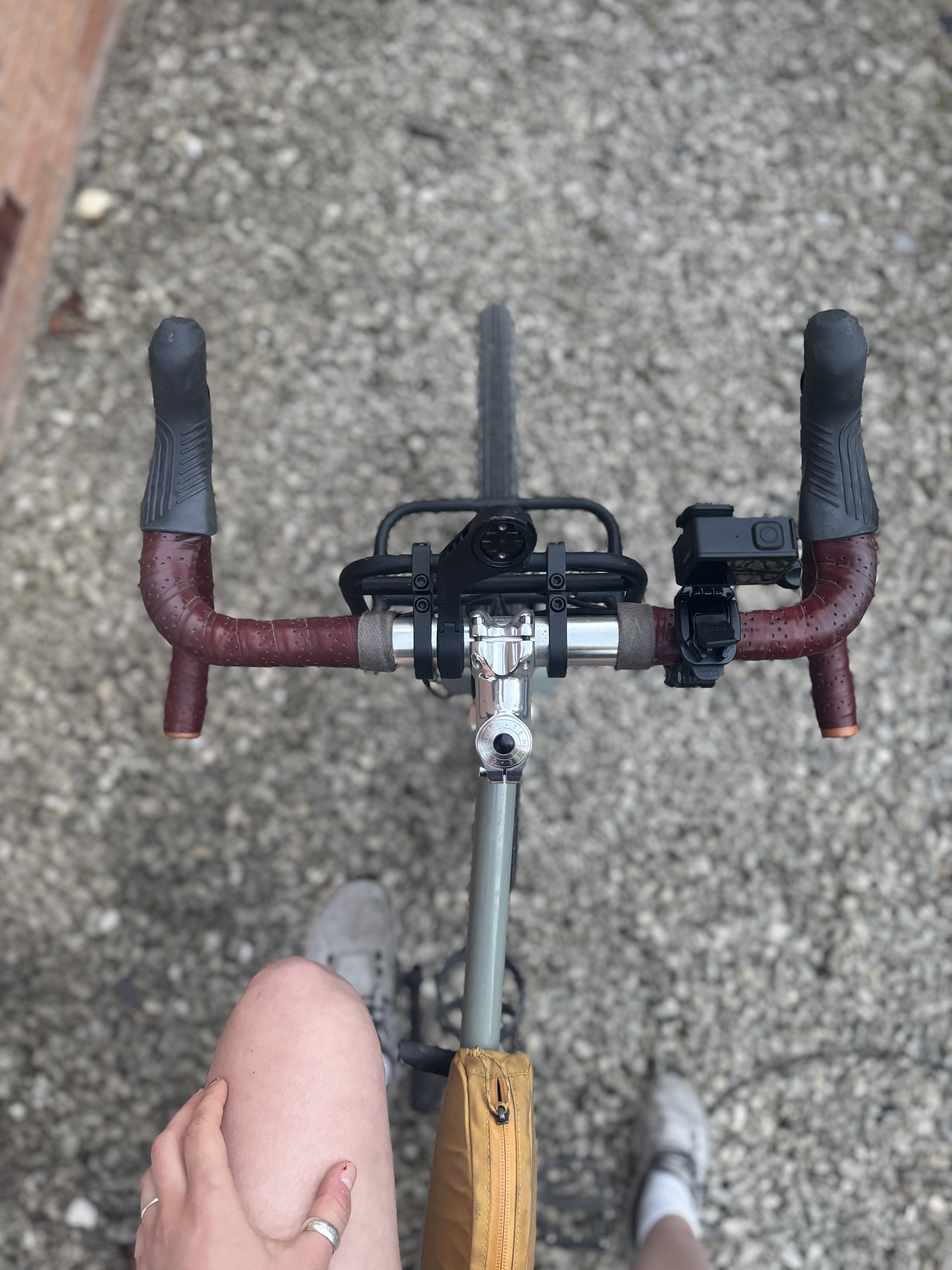Cyclingnews Verdict
The GoPro Hero 4k is a perfect action camera for those wanting a simple, easy to use experience. However, it is easily outgrown, and is limited compared to more premium options, as well as having some annoying subscription add-ons that are needed to make the most of it.
Pros
- +
Incredible price for such high quality footage
- +
Simple and super easy to use
- +
Lightweight and portable
- +
Beginner friendly
Cons
- -
Few features so you might outgrow it
- -
Not the best battery life
- -
Not great in low light
You can trust Cyclingnews
If you’re an avid cyclist or frequenter of the great outdoors, it is unlikely that you’ve not come across GoPro, even if the closest you’ve come is seeing another trail user with a little black box stuck on their helmet. Known for their rugged versatility, GoPro cameras have been the go-to for action enthusiasts for years.
To me, GoPros aren’t just some of the best action cameras on the market, they are the definition of action cameras (despite now having far more competition in that space), and so this latest iteration - a lightweight, smaller, and handier version for a slightly more palatable price point (£169 / $199) - piqued my interest.
Six years ago, I bought my very first GoPro - the mighty Hero 8 - and it quickly became a staple part of my kit, still going strong today. I became curious: Would the GoPro Hero 4K become my new staple action camera and finally convince me to upgrade from my beloved (but tired) GoPro Hero 8?
First impressions
Out of the box, I realise that this thing is both light and tiny. Weighing in at 86 grams (just over 3oz in freedom units), it’s noticeably lighter than my ancient GoPro Hero 8, which, back in the day, I thought was the lightest an action camera could possibly be. Mounted to a helmet, the GoPro Hero 4K was almost imperceptible. Sling it in your bikepacking bags and you’d never notice it’s there.
From an aesthetics perspective I like how small and portable it is. As there's only one rear camera and two buttons it’s pretty discreet - which is good if you’re still a bit embarrassed to be seen in public with a ‘camera’ camera. I even like the little venting detail on the front, which feels like a nice modern addition to the classic rugged casing.
And it really is rugged. Despite being small, it is mighty. If you’ve never used a GoPro before you might be surprised with how much neglect these things can tolerate (I once dropped mine off the side of the mountain and watched it bounce off every single craggy surface). Even with the screen and the lens, both relatively large surface areas made of glass, I’m not worried about dropping or scuffing it in the same way I would be with my phone, and that offers a lot more possibilities.
For much of this review period I had it either in my hand or on my bike mount, as this is where I think I capture the best footage, but does leave it slightly open to knocks, scrapes and stone flicks.
The latest race content, interviews, features, reviews and expert buying guides, direct to your inbox!

Performance and features
My favourite thing about the GoPro Hero 4K is how simple it is to use; and I love simplicity. This does end up being a bit of a double edged sword, and I will go into why shortly, but at its most basic GoPro has stripped back all the features to create a sort of action camera version of a point-and-shoot. If you’re a bit of a techno-phobe, there really isn’t much to mess up or freak you out on it. It has two buttons (On and off and the start and stop recording button) and then a screen on the back. The screen is just big enough to allow you to swipe through the different settings, or use voice control (which works well, once you figure out the correct wording). As there’s so little you can change on the camera, even big fingered cyclists like my dad were able to quickly navigate through the options.
There’s no microphone input, so this is not the camera you should go for if you want an all-rounder for more ‘vlogging’ footage. The audio is fine, but if you’re going to do any additional editing with fancy voiceovers, you’ll have to go back to good old-fashioned claps to sync up the audio. It did a better job than I was expecting however. Even when standing close to a motorway (the loudest place I could find out in rural Cheshire where I live), you can still hear me pretty clearly. GoPro does have a bit of a wind problem though, picking up even the slightest of breezes, so if you’re looking to make the audio a little clearer, you might want to consider a stick on dead cat muffler as a quick DIY hack.
As there is no replaceable battery (more on this later), the casing is waterproof up to 16ft (4.8m). To test this, I took it out swimming with me in my local lake. It was absolutely fine for the full 30 mins of swimming in 9 degree celsius water (or practically baltic for our American friends), which meant it fared far better than I did. You’ll have no problems taking it out in pouring rain, if you are so inclined, especially as it comes with a little interchangeable hydrophobic lens. This was something I was super excited to discover on it - no more rain droplets wrecking my shots! The relief! The lens, I was pleased to find, works impeccably, although after a few uses slung in various bags, it does pick up fingerprints quickly so you’ll need a microfibre cloth on hand at all times.

If you’re an accessories geek, you’ll be happy to know that the GoPro Hero 4K still has a huge - and I mean huge - range of mounts you can purchase for exciting and varied shots. You have the usual chesty, helmet and handlebar mounts, and then more novel accessories such as the ‘bite mount’ and even kits to attach to your dog’s harness. If you already have mounts from previous GoPro purchases, you’ll be pleased to know they still fit. Unlike the GoPro Hero Black 13 though, the premium-est of premium cameras in GoPro’s range, you don’t have the wide selection of lenses to shake up your footage. It offers a PolarPro shutter collection which provides a more cinematic filter, but other than that you are stuck with the footage from the camera.
To edit your footage, the quickest and most convenient way to edit using the Quik App. I was pleasantly surprised to find it much better than I remembered. A few years ago I stopped relying so much on my GoPro when the upload and camera pairing became completely unsustainable with crashes and endless loading loops. Thankfully though it does look like it has made some stability changes to the app now, and it hasn’t crashed once since I have used it.
Contrary to its name, I still don’t think it is the quickest at finding the camera and downloading the media, but you can now smash a very basic edit together on it reasonably fast. You can crop the length of the video, add a few filters, apply some music, adjust basic settings including contrast and brightness all in the app. I find the controls quite intuitive too, if you’ve done basic editing on your phone or in a phone app before, you’re unlikely to be confused by anything in the Quik App.

Footage
The GoPro Hero 4K shoots in - you guessed it - 4K resolution at 30 frames per second (fps). If you’re looking to save battery or storage, you can drop it down to 1080p at 60fps, which still looks pretty good, especially for faster-paced cycling shots where you can afford to lose a bit of detail.
I do generally find GoPro a little bit flat and washed out even in good light (especially in bright sunlight!), and despite the 4K on the Hero, the criticism still stands. Personally, I’m not massively fussed about this; for the price, it still feels like it produces high enough quality recordings for this to be reasonable. You can easily tweak the footage in editing software afterwards anyway, including quick little adjustments and filters in the Quik app, if you’re looking for a more vibrant look. In low light, it struggles a bit with noise and loses some clarity, so it’s not the best for twilight rides or shooting indoors. Still, even at dusk, I was pleased by how much detail it captured.
The camera can shoot in a 4:3 aspect ratio that means you can still create some good content for vertical-first platforms like Instagram, TikTok and YouTube shorts, which I liked. If I am going to be a tiny bit picky here, I would say that the 4:3 ratio seems to just punch in on your video which makes it quite hard to upload to youtube shorts without some fiddling, and the fish-eye lens in that taller perspective does feel a little bit antiquated (if you care about such things), but ultimately it does give you some options, which for this camera is pretty good.
The biggest draw though for anyone thinking about getting the GoPro Hero 4K is unquestionably going to be for the image stabilisation, which I can wholeheartedly say, has improved dramatically since the Hero 8. I’m currently recovering with a broken ankle, so I took the GoPro for as rutted of a ride as I could possibly manage, and was incredibly impressed with the footage I pulled off the camera. You can see how hard my hand is vibrating yet the camera doesn’t glitch or blur at all. Of all the things on this camera, this was perhaps the most noticeable upgrade in six years from my previous purchase.
Limitations and problems
Here’s where things begin to take a very slight nose dive, however. At 40% of the price of the flagship GoPro Hero Black 13 I knew there were going to be some compromises, I just wasn’t sure exactly how many compromises there would be. And there are a few, it turns out.
The first of the many things that began to annoy me about the GoPro was the prompting to purchase a subscription to access ‘premium’ features such as advanced image stabilisation and cloud upload the second I took it out of the box. Forgive me if I begin to sound a little like my dad, but I fundamentally disagree with tech that paywalls features that should be included in out-of-the-box. In Ye Olde Days of Hero 8 Yore (2019), we didn’t have such things as additional subscriptions for every usable feature and I miss those days. I have subscription fatigue, and really didn’t want another one.
However; after using it for a few months I do fear I must eat my own words. I hate to admit it but if you’re going to buy the Hero 4K, I would suggest going for a premium subscription. You have two tiers - the Premium and Premium Plus - both offering cloud storage (very important), guaranteed camera replacement (also very important), auto upload of your footage (very helpful) and 50% off GoPro Accessories (very important and helpful). The Premium is priced at £24.99 per year which I think is pretty reasonable, while the Premium plus is at £99 per year, and offers the addition of ‘Hypersmooth’ (advanced video stabilisation) which for mountain bikers or trail riders is an absolute must to get that high quality feel. At the very least, the purchase of a couple of accessories at up to half off pays for the premium subscription alone, and the added bonus of cloud storage means you can free up some space on your phone.
At the beginning of this review I mentioned that part of my interest in the GoPro Hero 4K was that it was simple to use. After using it for a while though, I wonder if it has taken the idea too far and pared slightly too much of the things I loved about GoPro back.
Firstly, you can’t really change any of the settings on the camera. There’s no way to change the frames per second or to change the type of lens you’re shooting with. You don’t have anything like time lapse which is a shame (because I am a sucker for a time lapse), and the slo-mo setting at 60fps is more like slow-er motion than true slow motion. Equally, don’t expect any outstanding photographs to be taken on the GoPro, you’ll probably capture something better from your phone.
And again, I know I am being a bit nit-picky here, but GoPro has moved around where the playback for your videos lives. The first draft of this review had an eloquently written but scathing paragraph on how stupid it was to have an action camera with no playback feature - especially for a cycling action camera - when I accidentally dropped it and found it was playing back my last recording. I then had to spend a full 15 minutes trying to find out how to find the feature properly. For a camera that seems to have prioritised simplicity, this was remarkably hard to find (swipe down from the top). I could have googled it, but I am my father’s daughter, and thus know reading the instructions is always a sign of weakness.
GoPro doesn't provide any internal storage so you will need to purchase an additional SD card to be able to use it on day one straight out of the box. This tripped me up initially when I received the review package, and I had to trawl every draw in my house to find a microSD I knew I’d have somewhere. Make sure you factor that additional cost of approximately £30 - £70 into any budget decisions. It isn’t a deal breaker, as most people want to upgrade their storage anyway, but it’s annoying to not be able to use the camera on day one if you aren’t prepared.

One of the things I loved about my GoPro Hero 8 was that it had interchangeable batteries. It meant that I could literally keep shooting footage all day, because I’d swap out the batteries into a little charging module and just keep replacing them. It was incredibly convenient and ultimately prolonged the life span of the camera. Unfortunately though, you won’t get that with the Hero 4K, as GoPro sealed the battery compartment meaning you’ll have to carry around extra battery packs if you have long days planned in the saddle. In saying that though, most of us record in short 30 second to 3 minute bursts, and with the screensaver on and in low battery mode I don’t think the battery life is complete trash. You can get, by my reckoning, at least 4 hours of intermittent usage out of it, and that was on a cold day, which felt decent.
Though it’s a bit of a pointless test, I did test the Hero 4K with a constant record and I got about 57 minutes. This is significantly lower than other user reviews that came in at 90 - 100 minutes and I suspect the camera overheated: it died at 29% and was quite hot to the touch which was quite disappointing. When I repeated the test, I got a slightly improved 65 minutes, but still considerably lower than the 90 minutes I’d expected. I doubt many of us will be doing a continuous record for more than an hour - especially as there is no timelapse option.
Charging it from empty also takes (metaphorically) forever. I think I’ve been utterly spoiled by all my ‘super fast’ charging tech, and waiting a whole 70 minutes for it to get to 100% seemed excessive in 2025, particularly when waiting for it to charge so you can get out for a ride. It does, however, come with a USB-C charging cable, which caused me to jump for joy when I saw it in the box. Thank you, GoPro Gods, for making this change. If I’d have ended up with yet another highly specific charging cable I think I would have just outright refused to review it.
Perhaps most crucially though, once I was again comfortable with the GoPro, I was very suddenly left wanting. I felt I’d outgrown this little action camera; I really wanted to mix it up, shooting in different styles and settings for road or trail and to be able to distinguish between them in the playback. It felt very much like a beginner’s camera and I wanted to do more with it much quicker than I anticipated.
Final thoughts
This is an action camera for beginners, or for someone who wants something straightforward and rugged to take out on their daily adventures. It isn’t glamorous or feature rich and provides a generally alright experience. It has good quality footage, picks up audio fine, is easy enough to use and sync to your phone. It’s a nice staple to have as part of your kit, and if you’re the kind of person who just wants a reliable action camera, has no plans to be making super high quality content, and just wants something simple to use, it absolutely does the business.
I personally wish it had replaceable batteries and the option of microphone input, but other than that, it isn’t a bad camera at all to start out with. Despite my list of negatives, I actually enjoyed the simplicity of it, and probably would have started here myself a few years ago when I was looking for an action camera for my own adventures. GoPros are fun, versatile and rugged cameras, and I have enjoyed playing around with this one immensely. And after all, why do we need the highest quality, sparkliest, most feature rich version of everything? Whatever happened to embracing and celebrating the adequate?
My main trepidation with the Hero 4K, however, is that it claims to be a cheaper alternative, yet after buying an additional SD card and paying the subscription, you are still forking out a fair chunk of cash for an essentially very basic camera. In saying that, there really isn’t anything else that is comparable on the market at this price point. The next best competitor - the DJI Osmo Action - is a much closer competitor to the more expensive GoPro Hero Black 13 and though the Insta 360 X3 has been well hyped, it offers a very different footage experience with big files to edit.
The new Hero Black 13, with so many more features, versatility, and gadgets to make it more usable on the trails is only £129 more and part of me wonders whether it is a better investment to upgrade if you have the available cash - it’s likely to have a much longer lifespan and might be a good investment, especially if you already have an older go pro like I do.
However, overall, I am going to admit it: the GoPro Hero 8 has been replaced in my kit bag by this newer and younger little GoPro Hero 4K and I don’t hate that fact.
| Audio Quality | 6 | /10 |
| Video Quality | 8 | /10 |
| Form factor | 10 | /10 |
| Included Software | 7 | /10 |
| Value | 7 | /10 |
| Overall | 75 | % |
You must confirm your public display name before commenting
Please logout and then login again, you will then be prompted to enter your display name.
